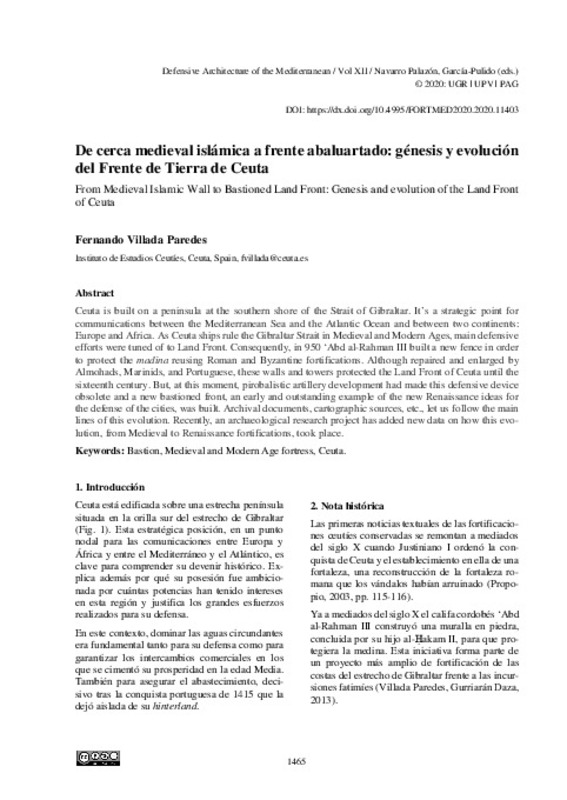JavaScript is disabled for your browser. Some features of this site may not work without it.
Buscar en RiuNet
Listar
Mi cuenta
Estadísticas
Ayuda RiuNet
Admin. UPV
De cerca medieval islámica a frente abaluartado: génesis y evolución del Frente de Tierra de Ceuta
Mostrar el registro sencillo del ítem
Ficheros en el ítem
| dc.contributor.author | Villada Paredes, Fernando
|
es_ES |
| dc.coverage.spatial | east=-5.321345499999999; north=35.8893874; name=Av. de África, 1, 51001 Ceuta, Espanya | es_ES |
| dc.date.accessioned | 2020-07-03T11:04:30Z | |
| dc.date.available | 2020-07-03T11:04:30Z | |
| dc.date.issued | 2020-05-15 | |
| dc.identifier.isbn | 9788490488560 | |
| dc.identifier.uri | http://hdl.handle.net/10251/147372 | |
| dc.description.abstract | [EN] Ceuta is built on a peninsula at the southern shore of the Strait of Gibraltar. It’s a strategic point for communications between the Mediterranean Sea and the Atlantic Ocean and between two continents: Europe and Africa. As Ceuta ships rule the Gibraltar Strait in Medieval and Modern Ages, main defensive efforts were tuned of to Land Front. Consequently, in 950 ‘Abd al-Rahman III built a new fence in order to protect the madina reusing Roman and Byzantine fortifications. Although repaired and enlarged by Almohads, Marinids, and Portuguese, these walls and towers protected the Land Front of Ceuta until the sixteenth century. But, at this moment, pirobalistic artillery development had made this defensive device obsolete and a new bastioned front, an early and outstanding example of the new Renaissance ideas for the defense of the cities, was built. Archival documents, cartographic sources, etc., let us follow the main lines of this evolution. Recently, an archaeological research project has added new data on how this evolution, from Medieval to Renaissance fortifications, took place. | es_ES |
| dc.language | Español | es_ES |
| dc.publisher | Editorial Universitat Politècnica de València | es_ES |
| dc.rights | Reconocimiento - No comercial - Sin obra derivada (by-nc-nd) | es_ES |
| dc.subject | Fortifications | es_ES |
| dc.subject | Mediterranean | es_ES |
| dc.subject | Modern age | es_ES |
| dc.subject | Built Heritage | es_ES |
| dc.subject | Bastion | es_ES |
| dc.subject | Medieval and Modern Age fortress | es_ES |
| dc.subject | Ceuta | es_ES |
| dc.title | De cerca medieval islámica a frente abaluartado: génesis y evolución del Frente de Tierra de Ceuta | es_ES |
| dc.title.alternative | From Medieval Islamic Wall to Bastioned Land Front: Genesis and evolution of the Land Front of Ceuta | es_ES |
| dc.type | Capítulo de libro | es_ES |
| dc.type | Comunicación en congreso | es_ES |
| dc.identifier.doi | 10.4995/FORTMED2020.2020.11403 | |
| dc.rights.accessRights | Abierto | es_ES |
| dc.description.bibliographicCitation | Villada Paredes, F. (2020). De cerca medieval islámica a frente abaluartado: génesis y evolución del Frente de Tierra de Ceuta. Editorial Universitat Politècnica de València. 1465-1472. https://doi.org/10.4995/FORTMED2020.2020.11403 | es_ES |
| dc.description.accrualMethod | OCS | es_ES |
| dc.relation.conferencename | FORTMED2020 - Defensive Architecture of the Mediterranean | es_ES |
| dc.relation.conferencedate | Octubre 01-03,2020 | es_ES |
| dc.relation.conferenceplace | Granada, Spain | es_ES |
| dc.relation.publisherversion | http://ocs.editorial.upv.es/index.php/FORTMED/FORTMED2020/paper/view/11403 | es_ES |
| dc.description.upvformatpinicio | 1465 | es_ES |
| dc.description.upvformatpfin | 1472 | es_ES |
| dc.type.version | info:eu-repo/semantics/publishedVersion | es_ES |
| dc.relation.pasarela | OCS\11403 | es_ES |








